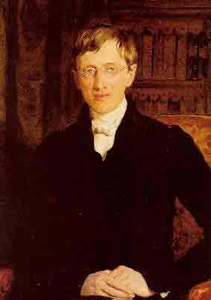Apologia Pro Vita Sua, Chapters I and II
Newman's Early Influences and Confidence in the Oxford Movement
Newman's Early Influences (Chapter I, Apologia)

Childhood
- Arabian Tales. Isaac Watts' "Remnants of Time"
- (Age 14) Voltaire, Thomas Paine, David Hume's Essay on Miracles
Evangelical Conversion
- (Age 15) Evangelical Conversion--Calvinist authors-William Romaine
- Thomas Scott, Daniel Wilson, Jones of Wayland--early doctrinal thought and preachers--opposition to double predestination and antinomianism
- William Law's Serious Call
- Joseph Milner, Church History; Thomas Newton, work on biblical prophecies
Move Toward Liberalism
- 1822--fellow at Oriel College --influence of Noetics--Richard Whately,
- Edward Hawkins--learned form them views on tradition, baptismal regeneration; Whatley in particular taught Newman to think and imparted to him an anti-Erastian view of church
Move Toward Anglo-Catholic Positions
- William James--apostolic succession, visible church
- Joseph Butler's The Analogy of Religion (1736)--nature of probability
- Edward Pusey and Keble--Tractarian cause
- Hurrell Froude--love for Medieval Xny
- Devotion to the Patristics, esp. Origen and Clement of Alexandria
Newman’s Works and Views in Apologia Chapter II
Question: Which of the following works by Newman express a settled opinion at the time and which ones express a transition in his thinking? Likewise, which ones does he cite as an example of his cast of mind and which ones does he cite for the responses of others to him?
- Letters to The Record (church newspaper)
- Tracts for the Times (in particular Tract 15, 71, and 90)
- Arians of the Fourth Century
- Prophetical Office of the Church
- Essay on Justification
- University Sermons
- The Church of the Fathers (in British Magazine)
- Translations of Fleury’s Church History & Treatises of St. Athanasius
Three Confident Positions (pg. 50-53)
- The principle of dogma as opposed to Liberalism’s dependence upon reason and sentiment alone. Dogma is the only way to secure one’s religion and faith. (Sources: Scripture, Prayer Book, Epistles of Ignatius)
- The Visible Church, founded upon the Episcopal system, is the channel of invisible grace through the sacraments, with the bishops as the successors of the apostles carrying almost sacramental reverence and authority. (Sources: Acts, Biblical Epistles, Prayer Book, Ignatius)
- View of the Roman Catholic Church, which he eventually abandons: View of the church as a fallen sister, holding much in common with the Anglican Church but having transgressed in important areas.
Prophetical Office (pg. 63-67)
- Desire to set out a clear and lively view of the Anglican Church based neither on Evangelical “low church” positions or Latitudinarian “broad Church” positions but on “Apostolic” “primitive church” positions (i.e. Patristic Christianity), close in spirit to the Anglican divines of the 17th century.
- The Via Media (“The Middle Way”): The belief that the Anglican, Roman, and Eastern Orthodox Churches are all branches of the true One, Apostolic, Catholic Church, but with the implication that the Anglican branch is closest to that primitive root.
Tract 90 (pg.73-79)
Why the Calvinistic sounding 39 Articles of the Anglican Church can nonetheless have an Anglo-Catholic reading:
- “Popery” was more of a political concern for Henry VIII, in particular the doctrine of papal supremacy, so the Articles were written with that in mind.
- The Articles were meant to draw back in the party of the “papists” not alienate them.
- Many aspects (twenty-six listed) of it actually assume “Papistical” doctrines (cf. 74-75)
- Council of Trent not over at the time the Articles were written, so they were not meant to address Trent ’s Counter-Reformation stances; the Homilies serve as best commentary on the Articles.
- The Convocation of 1571, which received the Articles, stressed to preachers to preach the apostolic, Catholic beliefs held by the people.
- Elastic language in the Articles themselves allow for differing interpretations (e.g. on justification).
Newman stresses that this was an “essay,” a first foray into the subject and one that he would gladly corrected or withdrawn if corrected; thus, his shock at the public outrage over it.
